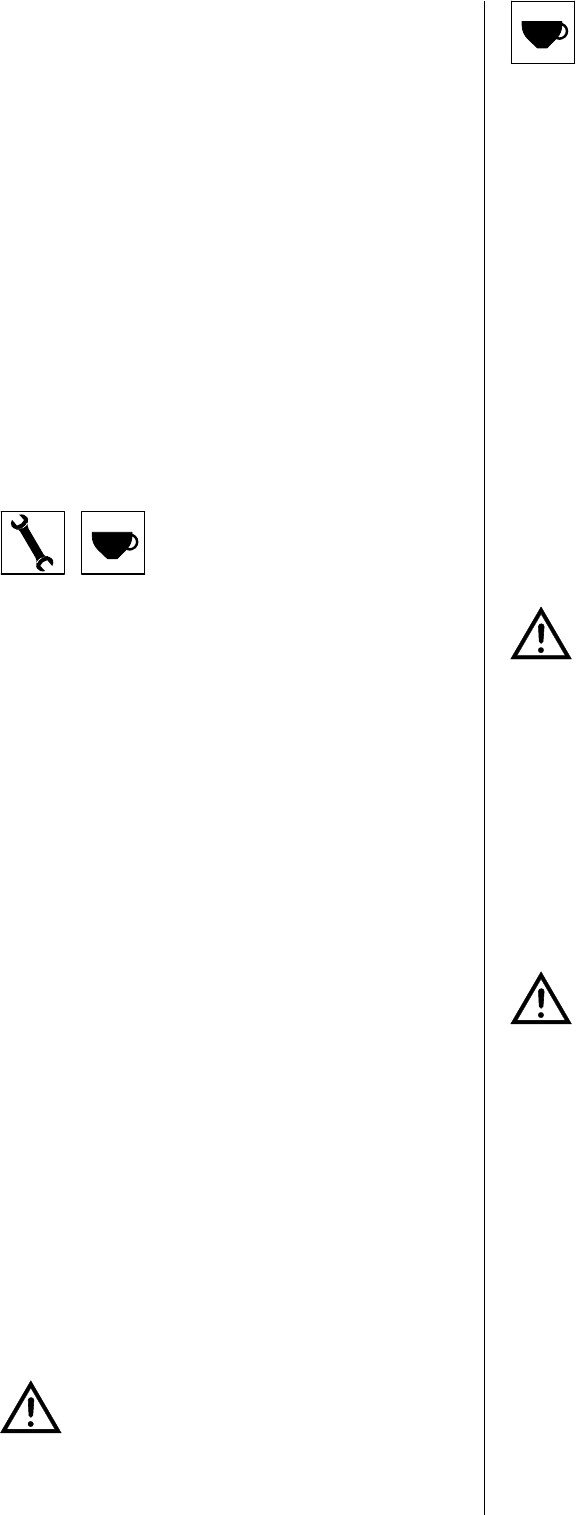
48
7.3. Starting up
Model S
● Turn on the water supply tap 2 Fig.6.
● Turn the main switch 1; the pump is activated, filling
the boiler.
● When the level has been reached the pump stops,
then activate switch 2 to begin heating the water
in the boiler then turn each one until water begins
to flow from them.
● Wait for the machine to reach its working pressure,
and to reach the correct thermal balance.
Model DE - CD
● Turn on the water supply tap 2 Fig.6.
● Turn on main switch 1 and resistance switch 2.
The pump for boiler filling will activate (red led on
level indicator 10).
● Only after reaching the level (green led on level
indicator 10) the resistances for water heating in
the boiler are powered,then activate every single
group until water comes out.
● During the heating phase the leds of the keys
switch on in sequence from left to right until the
working pressure is reached.
Only when the rated pressure is reached it is
possible to adjust the doses for DE model.
Warning! This sequence will be repeated at
every switching on.
8 Supplementary manual water supply tap po-
sitioned under the cup-stand grille and normally
kept turned off.
Turn on the tap to fill the boiler and turn it off when
the correct level is reached.
7.2. Control instruments (Fig.7)
9 Gauge with mobile needle on a fixed dial with a
double scale.
Visual control of the pump (lower manometer ) and
of the boiler pressure (upper manometer) (mod.
E-S).
10 Minimum and maximum water level indicator .
Visual control of water level in boiler (green
Led).
11 Cup-heater switch (optional).
Two-position switch with led.
By turning on the switch (led on), the cup heating
resistance is power supplied.
8. USE
The machine has a top shelf on which the cups are
kept and heated, ready for use.
This is very important to obtain good coffee as the
pre-warmed cup stops the coffee from growing cold
too quickly.
8.1. Preparing coffee
● Unclamp the filter-holder from the dispensing unit
and knock any grouts out into the drawer espe-
cially provided for this purpose, taking care not to
damage the rim of the filter.
● Use the filter for 1 or 2 coffees, according to
need.
● Fill the filter with the measure of coffee, level it off
and press it down gently with the presser.
● Remove any ground coffee that has stuck to the
rim of the filter while pressing.
If ground coffee is left on the rim of the filter, a
leaktight seal is not ensured, with consequent
leaking of water and coffee grounds.
● Lock the filter-holder into the dispensing unit firmly
to obtain a leaktight seal.
● Place the cups under the spouts and start pouring
using control 3 - 4 or button panel 5 according to
model (Fig.7).
● When the coffee has been poured, leave the filter-
holder attached to the dispensing unit until the next
coffee is required.
When pouring, beware of the hot parts of the
machine, especially the coffee dispensing
units, the steam and hot water spouts. Do not
put your hands for any reason under the units
and the spouts when they are operating.
The grinding of the coffee beans is of fundamental
importance to the making of good coffee, and the
granular texture of the resulting grounds should be
such that it takes 25-30 seconds to produce the
beverage. If the coffee is ground too coardsely the
coffee will be pale in colour and weak in flavour, with
only a very small amount of white cream, and if the
grounds are too fine, the coffee will be dark with no
cream. Good coffee can only be made if the beans
are freshly and uniformly ground (only possible when
the blades of the coffee grinder are sharp) and are
then measured out into the correct quantities (roughly
6 grams per measure).
The importance of freshly ground coffee beans is due
to the fact that once ground, they rapidly lose their
aromatic qualities, and fats present in the beans go
rancid.


















